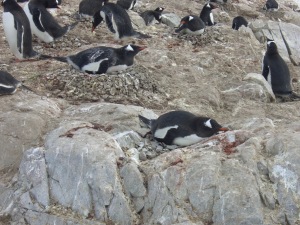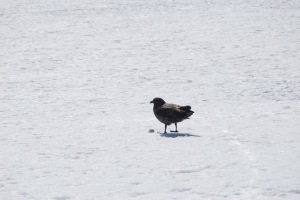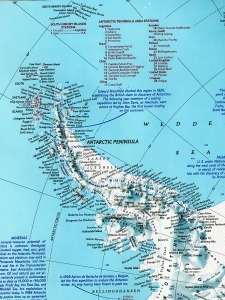
As courtship begins, a male penguin wins his female because he has brought sufficient rocks (in his beak, one at a time) to build the nest for the egg. The gentoo, or fatter penguin, produces only one egg. The gentoo is the most faithful spieces and stays close to shore. It tends to be a stay at homer, rather than swimming away at sea for the winter only to return at this time to their very same nest (how one knows, I have no idea) to wait for the very same lady penguin he mates with every year. This is true. Penguins are faithful to mates and location. Now if a male returns first and gets restless and begins to worry if his female is not going to return (she may have been killed at sea) he might go ahead and take on a new mate. If the original female does happen to return late, then there is a horrible fight between the girls. It’s not the males who fight, just the girls.
Learning about penguin culture is fascinating. The best way to do this is just sit on the snow and watch.
 Keeping the Nest No Matter What
Keeping the Nest No Matter What
Yesterday, Thanksgiving Day, about 10 in the morning, accompanied by soaring and diving birds such as southern giant petrals, Blue Eyed shags, skuas (the garbage men of Antartica) and storm-petrals, we had gotten well south of the 60th parallel and saw our first iceberg – a huge monster bigger than the FedEx Forum but flat on top like a huge plateau. These didn’t look any different than the icebergs of Greenland with the same sapphire blue color at the water’s edge. As we passed this first one on the starboard side, we quickly ran to the port side and saw many more gigantic bergs and amazing snow-covered rock formations of the islands. In an ice floe cracking a part, the captain spotted a sleeping seal, a giant one, and we, the huge ship crept up to it without disturbing its sleep and took a thousand pictures of a dot as we got closer. The seal lifted its head once but decided to stay where he was. We were no threat in his waters.
We then approached the South Shetland Islands, our first sight of Antarctic land. (Cheers! It meant we were in a protected area and the rough seas would be left behind. We had arrived at our playing field.) William Smith had first discovered this archipelago (known as the Antartica peninsula) in 1819. But thousands of American and British sealing vessels heard about the wealth of fur seals breeding there. Within two years, they had completely eliminated them all so women and men could wear sealskin coats. Isn’t that typical?
Our landing (in Zodiacs) was to be at [Barrientos] Island on the Aitcho Islands. But first, we had a mandatory Antarctic Landing briefing about how to dress (long underwear, waterproof pants and jacket, layers of shirts and sweaters, heavy wool cap or hood, gloves in gloves, and a backpack for cameras kept in plastic bags, for extra batteries recharged and for extra digital cards because, we were told, we could easily take 500 photos of penguins and not know it.) and how to enter a Zodiac (waterproof boots essential – you will have to step into water) and how to behave when a penguin crosses our path. Go slow. Watch the periphery. Penguins have right of way. The rules are strict in order to preserve the regularity of the penguins en vironment, not to disturb them, or disrupt their routine. We were not to leave any sort of footprint in the land. (If it had been exposed bogs or the time of year when there is moss, grass or ground cover, we were to walk on exposed rock, not the growing plant material.) By the time the staff rep was finished, I was scared to death I’d do something wrong or not even make it back to the Zodiac. Mind you it was well below zero in winds that must have added twenty-five degrees to the minus sign. East guest must flip a switch by her room number when leaving the ship and then again when re-boarding. Since we wear life jackets in the Zodiac, we deposit them in a box by the landing site. If any remain when we returned to the ship, then the staff knew someone was still wandering.)
vironment, not to disturb them, or disrupt their routine. We were not to leave any sort of footprint in the land. (If it had been exposed bogs or the time of year when there is moss, grass or ground cover, we were to walk on exposed rock, not the growing plant material.) By the time the staff rep was finished, I was scared to death I’d do something wrong or not even make it back to the Zodiac. Mind you it was well below zero in winds that must have added twenty-five degrees to the minus sign. East guest must flip a switch by her room number when leaving the ship and then again when re-boarding. Since we wear life jackets in the Zodiac, we deposit them in a box by the landing site. If any remain when we returned to the ship, then the staff knew someone was still wandering.)

The landing site was not huge but every inch was packed with penguins – and there was one fat, lolling, lethargic, happy hairy elephant seal right in the middle of one of the rookeries on the beach at a lake. The gentoo and chinstrap penguins (they have a black strip under their chins that looks like a helmet strap) are busy staking claims to their piece of ground. They set up nests within pecking distance of each other. There are three penguine species on Antarctica – today we were introduced to two, with the Adelie penguins yet to come. We have penguin experts on board and two American girls from the non-profit Oceanites who are counting nests and eggs.
Two things about visiting penguin environments – 1) they stink and 2) they’re noisy. Although a group might number a hundred or so, every now and then a male will stretch up high, put his beak in the air and shake his shiny neck as he makes loud duck and bird sounds. He is saying, this is MY HOUSE. Don’t come close. Then everyone choruses a opinion. Yet, there is no animosity between species or within species – except, as I pointed out, between the females. Of course, in penguins, you can’t tell which is which – and both sexes incubate the eggs between their legs. All penguins go through a traumatic time each year when they molt feathers – called a catastrophic molt – the penguin stands in one place for three weeks as he loses his feathers and new ones come in. The arch enemy of penguins are the brown scuar who will steal an egg faster than a pickpocket. We saw one do such a trick, break it open, and feast. What can you say? It’s nature at work.
 Gotcha Ya, said the Scaur
Gotcha Ya, said the ScaurWe will see more penguins as the week goes on and if the weather calms down so we can get ashore. Right now it’s snowing thickly and rumors are a storm is coming. Batten down the hatch.



Delightful! Penguins are so playful in such a harsh environment. Tried to send you video of the sinking ship and rescue, but I’m not sure it worked. On a different subject what is the time difference there? MM